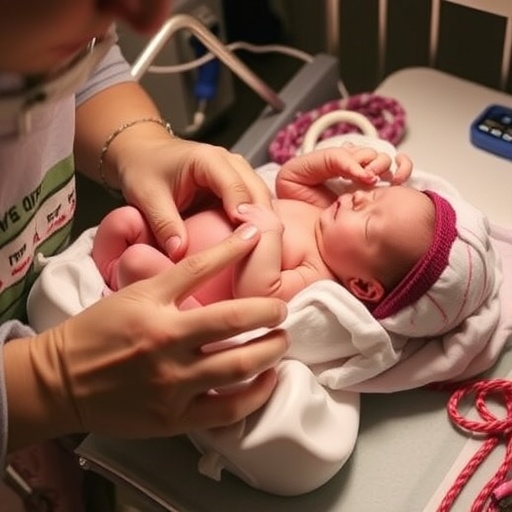In a groundbreaking advancement that could reshape neonatal care protocols worldwide, researchers have unveiled an alternative approach to neonatal resuscitation for bradycardia, specifically targeting heart rates below 60 beats per minute. Utilizing a sophisticated ovine model, this innovative study challenges long-standing conventions and offers a promising new pathway to improve outcomes for newborns facing critical cardiac distress immediately after birth.
Traditional neonatal resuscitation has long relied on a set of guidelines emphasizing prompt and aggressive intervention once heart rates fall below the critical threshold of 60 bpm. However, despite adherence to established protocols, neonatal bradycardia remains a formidable challenge, often culminating in suboptimal neurological outcomes or even mortality. The research team led by Bawa and colleagues strategically employed an ovine model, which serves as a highly relevant biological proxy to human neonates, to dissect the physiological nuances underlying bradycardia and corresponding resuscitative responses.
The choice of an ovine model is deliberate and insightful, as lamb physiology mirrors many aspects of human neonatal cardiovascular and pulmonary function, providing an ideal platform for precise experimental control and detailed hemodynamic analysis. This approach allowed the researchers to explore the impact of varied resuscitative maneuvers on heart rate recovery and systemic oxygen delivery, without the ethical and practical constraints inherently associated with direct human neonatal studies.
Integral to the study was the meticulous monitoring of heart rate dynamics alongside peripheral oxygen saturation and cerebral perfusion metrics during induced bradycardic episodes. This comprehensive data collection enabled a granular evaluation of the efficacy of the alternate resuscitation method compared to the traditional stepped oxygen delivery and ventilation approach typically endorsed in current neonatal resuscitation guidelines.
Central findings revealed that the alternate resuscitation technique, which diverges from immediate mechanical ventilation and high oxygen fractions, emphasized carefully titrated chest compressions synchronized with optimized oxygen delivery. This method resulted in more rapid normalization of heart rate while simultaneously reducing oxidative stress markers, which have been implicated in long-term hypoxic-ischemic brain injury in neonates.
Furthermore, the study’s physiological analyses uncovered critical insights about the timing and sequence of resuscitative interventions. Notably, delaying aggressive ventilation in favor of establishing effective chest compressions stabilized cardiac preload, thereby enhancing cardiac output and improving oxygen transport efficiency. These findings provoke a fundamental reevaluation of neonatal resuscitation algorithms, potentially advocating for a shift from reflexive respiratory support to a more circulatory-focused strategy in cases of severe bradycardia.
The implications of this research stretch beyond the immediate clinical environment, prompting a reconsideration of training and resource allocation within neonatal intensive care units globally. With emerging evidence suggesting that nuanced, model-informed resuscitation protocols can significantly augment survival rates and neurological prognosis, medical educators and policymakers may face pressure to update curricular frameworks and institutional guidelines accordingly.
Moreover, the study sheds light on the biochemical milieu associated with resuscitative efforts, highlighting reductions in oxidative biomarkers and inflammatory cytokines when the alternate method was employed. This biochemical perspective adds a compelling layer of understanding regarding how mechanical interventions translate into cellular and tissue-level protection, potentially paving the way for adjunct pharmacologic therapies tailored to support optimal recovery trajectories.
Beyond the immediate neonatal context, the methodological rigor exemplified in this ovine model study underscores the vital role of translational animal research in bridging theoretical knowledge and clinical applicability. By faithfully recapitulating the complexities of human neonatal cardiovascular distress, such models empower researchers to innovate safely and iteratively before human application.
Encouragingly, the data presented points toward reproducibility and scalability of this alternate approach, suggesting its feasibility for integration into a variety of healthcare settings, including those with limited access to advanced neonatal ventilation technologies. This holds profound significance for global neonatal health, especially in low-resource environments where the burden of neonatal morbidity and mortality remains disproportionately high.
Looking forward, the researchers advocate for multi-center clinical trials to validate these preclinical findings and to refine the alternate resuscitation protocol in diverse population cohorts. These future studies will be critical for assessing long-term neurodevelopmental outcomes and determining the generalizability of results across different genetic and environmental contexts.
In a broader scientific and societal context, this novel research trajectory exemplifies the dynamic interplay between technological innovation, biological insight, and clinical pragmatism that is essential for transformative healthcare breakthroughs. It offers a hopeful narrative that medical science continues to evolve in ways that can dramatically enhance the care and quality of life for society’s most vulnerable members—our newborns.
The revelations from this ovine model study may eventually not only redefine standards in neonatal resuscitation but also inspire a renaissance in pediatric critical care approaches worldwide. The marriage of detailed physiological experimentation with clinical ambition thus moves us closer to a future where neonatal cardiac crises are met with ever more effective, evidence-based interventions.
As the neonatal care community digests these findings, the unfolding dialogue will likely spark innovative research, refined clinical protocols, and, critically, improved survival and developmental trajectories for infants who start life with severe cardiac challenges. The promise inherent in this work heralds new hope for countless families and a compelling case study in the power of animal models to inform and transform human health practice.
Subject of Research: Neonatal resuscitation techniques for bradycardia using an ovine (sheep) model to explore alternative approaches to improve heart rate recovery and reduce oxidative injury.
Article Title: Neonatal resuscitation for bradycardia (HR < 60 bpm)—an alternate approach using an ovine model.
Article References:
Bawa, M., Gugino, S., Helman, J. et al. Neonatal resuscitation for bradycardia (HR < 60 bpm)—an alternate approach using an ovine model. Pediatr Res (2025). https://doi.org/10.1038/s41390-025-04444-9
Image Credits: AI Generated




